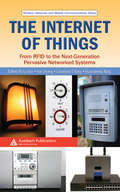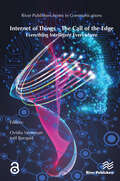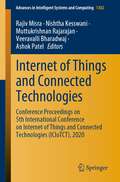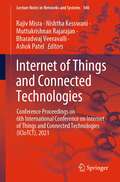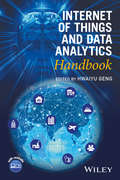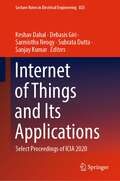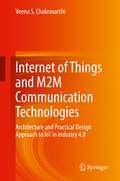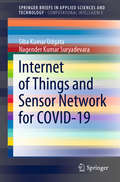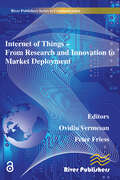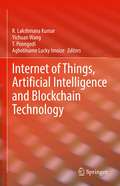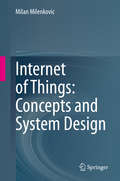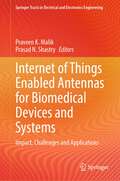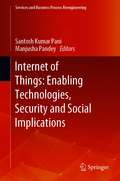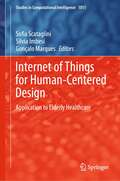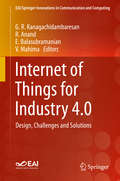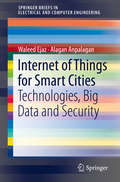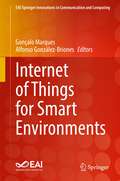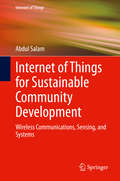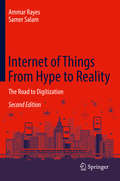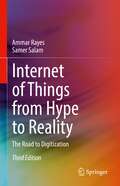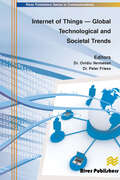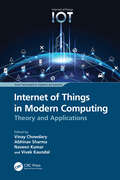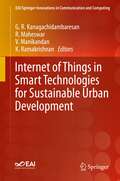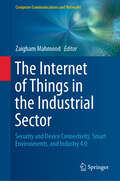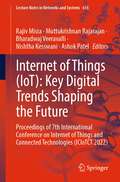- Table View
- List View
The Internet of Things: From RFID to the Next-Generation Pervasive Networked Systems (Wireless Networks And Mobile Communications Ser. #12405)
by Laurence T. Yang Yan Zhang Huansheng Ning Lu YanUbiquitous and pervasive technologies such as RFID and smart computing promise a world of networked and interconnected devices. Everything from tires to toothbrushes could soon be in communications range, heralding the dawn of an era in which today's Internet of People gives way to tomorrow's Internet of Things- where billions of obje
Internet of Things – The Call of the Edge: Everything Intelligent Everywhere
by Ovidiu Vermesan Joël BacquetThis book provides an overview of the Internet of Things (IoT) – covering new ideas, concepts, research and innovation to enable the development of IoT technologies in a global context. The work is intended as a standalone book in a series covering the activities of the Internet of Things European Research Cluster (IERC) – including research, technological innovation, validation, and deployment.The book chapters build on the developments and innovative ideas put forward by the IERC, the IoT European Large-Scale Pilots Programme and the IoT European Security and Privacy Projects – presenting new concepts, ideas and future IoT trends and ways of integrating open data frameworks and IoT marketplaces into larger deployment ecosystems.The IoT and Industrial Internet of Things technologies are moving towards hyperautomated solutions – combining hyperconnectivity, artificial intelligence (AI), distributed ledger technologies and virtual/augmented extended reality, with edge computing and deep edge processing becoming an assertive factor across industries for implementing intelligent distributed computing resources and data to keep the efficient data exchange and processing local to reduce latency, exploit the sensing/actuating capabilities and enable greater autonomy.Expanding the adoption of consumer, business, industrial and tactile IoT requires further development of hyperautomated IoT concepts for collaborative solutions involving machines and humans to expand augmented creativity at the application level using AI to optimise the industrial processes and progress towards a symbiotic economy based on distributed federated cloud/edge infrastructure allowing resource sharing in the form of computing, memory and analytics capabilities.The advances of autonomous IoT applications delivering services in real-time encompasses development in servitisation, robotisation, automation and hyperconnectivity, which are essential for the rapid evolution of industrial enterprises in the new digital era. The rise of digital twins integrated into IoT platforms as fully interactive elements embedded into the simulation and optimisation environment, as well as the embedment of AI techniques and methods, enhances the accuracy and performance of models in the various IoT and Industrial Internet of Things applications.The convergence of technologies to provide scalable, interoperable IoT-enabled applications pushed the requirements for high bandwidth, low latency and robust and dependable connectivity to support the industry’s demand for deeper integration and improved analytics to deliver sustainable competitive advantage products and services, enabling digital transformation with a focus on new business models.Safety and security are interlinked for the next wave of IoT technologies and applications and combined, prove a greater value for rapid adoption.The new IoT technologies are essential for facilitating sustainable development, reducing energy consumption and, by supporting the optimisation of products and processes, mitigating unnecessary carbon emissions – thereby reducing the environmental impact through real-time data collection, analysis, exchange, and processing.
Internet of Things and Connected Technologies: Conference Proceedings on 5th International Conference on Internet of Things and Connected Technologies (ICIoTCT), 2020 (Advances in Intelligent Systems and Computing #1382)
by Rajiv Misra Nishtha Kesswani Muttukrishnan Rajarajan Veeravalli Bharadwaj Ashok PatelThis book presents the recent research adoption of a variety of enabling wireless communication technologies like RFID tags, BLE, ZigBee, etc., and embedded sensor and actuator nodes, and various protocols like CoAP, MQTT, DNS, etc., that has made Internet of things (IoT) to step out of its infancy to become smart things. Now, smart sensors can collaborate directly with the machine without human involvement to automate decision making or to control a task. Smart technologies including green electronics, green radios, fuzzy neural approaches, and intelligent signal processing techniques play important roles in the developments of the wearable healthcare systems. In the proceedings of 5th International Conference on Internet of Things and Connected Technologies (ICIoTCT), 2020, brought out research works on the advances in the Internet of things (IoT) and connected technologies (various protocols, standards, etc.). This conference aimed at providing a forum to discuss the recent advances in enabling technologies and applications for IoT.
Internet of Things and Connected Technologies: Conference Proceedings on 6th International Conference on Internet of Things and Connected Technologies (ICIoTCT), 2021 (Lecture Notes in Networks and Systems #340)
by Bharadwaj Veeravalli Ashok Patel Rajiv Misra Muttukrishnan Rajarajan Nishtha KesswaniThis book presents recent advances on IoT and connected technologies. We are currently in the midst of the Fourth Industrial Revolution, and IoT is having the most significant impact on our society. The recent adoption of a variety of enabling wireless communication technologies like RFID tags, BLE, ZigBee, etc., embedded sensor and actuator nodes, and various protocols like CoAP, MQTT, DNS, etc., has made the Internet of things (IoT) step out of its infancy. Internet of things (IoT) and connecting technologies are already having profound effects on the different parts of society like the government, health care, businesses, and personal lives. 6th International Conference on Internet of Things and Connected Technologies (ICIoTCT), 2021, was a platform to discuss and feature research on topics such as augmented reality, sensor networks, and wearable technology. This book is ideally designed for marketing managers, business professionals, researchers, academicians, and graduate-level students seeking to learn how IoT and connecting technologies increase the amount of data gained through devices, enhance customer experience, and widen the scope of IoT analytics in enhancing customer marketing outcomes.
Internet of Things and Data Analytics Handbook
by Hwaiyu GengThis book examines the Internet of Things (IoT) and Cyber-Physical Systems (CPS) from a technical, economical and application point of view Examines cloud computing, data analytics, and sustainability and how they relate to IoT/CPS Covers the scope of both consumer IoT and enterprise/government CPS applications Includes best practices, business model and real-world case studies
Internet of Things and Its Applications: Select Proceedings of ICIA 2020 (Lecture Notes in Electrical Engineering #825)
by Sanjay Kumar Debasis Giri Sarmistha Neogy Keshav Dahal Subrata DuttaThis volume constitutes selected papers presented at the International Conference on IoT and its Applications 2020. The research papers presented were carefully reviewed and selected from several initial submissions on the topics - the Internet of Things (IoT) and its applications such as smart cities, smart devices, agriculture, transportation and logistics, healthcare, etc. The book contains peer-reviewed chapters written by leading international scholars from around the world. This book will appeal to students, practitioners, industry professionals, and researchers working in the field of IoT and its integration with other technologies to develop comprehensive solutions to real-life problems.
Internet of Things and M2M Communication Technologies: Architecture and Practical Design Approach to IoT in Industry 4.0
by Veena S. ChakravarthiThis book provides readers with a 360-degree perspective on the Internet of Things (IoT) design and M2M communication process. It is intended to be used as a design guide for the development of IoT solutions, covering architecture, design, and development methods. This book examines applications such as industry automation for Industry 4.0, Internet of Medical Things (IoMT), and Internet of Services (IoS) as it is unfolding. Discussions on engineering fundamentals are limited to what is required for the realization of IoT solutions. Internet of Things and M2M Communication Technologies: Architecture and Practical Design Approach to IoT in Industry 4.0 is written by an industry veteran with more than 30 years of hands-on experience. It is an invaluable guide for electrical, electronic, computer science, and information science engineers who aspire to be IoT designers and an authoritative reference for practicing designers working on IoT device development.Provides complete design approach to develop IoT solutions;Includes reference designs and guidance on relevant standards compliance;Addresses design for manufacturability and business models.
Internet of Things and Sensor Network for COVID-19 (SpringerBriefs in Applied Sciences and Technology)
by Siba Kumar Udgata Nagender Kumar SuryadevaraThis book examines various models/solutions in areas, such as individuals, home, work and society, where IoT and AI are being utilized to mitigate the Covid-19 pandemic. The world is battling with the novel coronavirus, and government authorities, scientists, medical practitioners, and medical services are striving hard to help people to face the challenges. During this crisis, numerous innovative ideas and solutions have been proposed for using the Internet of things (IoT), sensor networks, and artificial intelligence (AI) to monitor the wellbeing of individuals. Nations are using all available assets to help develop cutting-edge innovations to relieve the impacts of Covid-19 and profile individuals in danger. The advances in IoT frameworks and sensor technologies together with AI are invaluable in the context of this pandemic, and nations and various entities around the globe are discovering innovative solutions to maintain businesses and help people live alongside Covid-19. This book presents the advances in sensor technologies, IoT frameworks, and explores how these technologies are being used to deal with the issues arising from Covid-19, including work in progress and potential applications.
Internet of Things Applications - From Research and Innovation to Market Deployment: From Research And Innovation To Market Deployment (River Publishers Series In Communications Ser.)
by Ovidiu Vermesan Peter FriessThe book aims to provide a broad overview of various topics of Internet of Things from the research, innovation and development priorities to enabling technologies, nanoelectronics, cyber physical systems, architecture, interoperability and industrial applications. It is intended to be a standalone book in a series that covers the Internet of Things activities of the IERC – Internet of Things European Research Cluster from technology to international cooperation and the global "state of play".The book builds on the ideas put forward by the European research Cluster on the Internet of Things Strategic Research Agenda and presents global views and state of the art results on the challenges facing the research, development and deployment of IoT at the global level. Internet of Things is creating a revolutionary new paradigm, with opportunities in every industry from Health Care, Pharmaceuticals, Food and Beverage, Agriculture, Computer, Electronics Telecommunications, Automotive, Aeronautics, Transportation Energy and Retail to apply the massive potential of the IoT to achieving real-world solutions. The beneficiaries will include as well semiconductor companies, device and product companies, infrastructure software companies, application software companies, consulting companies, telecommunication and cloud service providers. IoT will create new revenues annually for these stakeholders, and potentially create substantial market share shakeups due to increased technology competition. The IoT will fuel technology innovation by creating the means for machines to communicate many different types of information with one another while contributing in the increased value of information created by the number of interconnections among things and the transformation of the processed information into knowledge shared into the Internet of Everything. The success of IoT depends strongly on enabling technology development, market acceptance and standardization, which provides interoperability, compatibility, reliability, and effective operations on a global scale. The connected devices are part of ecosystems connecting people, processes, data, and things which are communicating in the cloud using the increased storage and computing power and pushing for standardization of communication and metadata. In this context security, privacy, safety, trust have to be address by the product manufacturers through the life cycle of their products from design to the support processes. The IoT developments address the whole IoT spectrum - from devices at the edge to cloud and datacentres on the backend and everything in between, through ecosystems are created by industry, research and application stakeholders that enable real-world use cases to accelerate the Internet of Things and establish open interoperability standards and common architectures for IoT solutions. Enabling technologies such as nanoelectronics, sensors/actuators, cyber-physical systems, intelligent device management, smart gateways, telematics, smart network infrastructure, cloud computing and software technologies will create new products, new services, new interfaces by creating smart environments and smart spaces with applications ranging from Smart Cities, smart transport, buildings, energy, grid, to smart health and life. Technical topics discussed in the book include: • Introduction• Internet of Things Strategic Research and Innovation Agenda• Internet of Things in the industrial context: Time for deployment.• Integration of heterogeneous smart objects, applications and services• Evolution from device to semantic and business interoperability• Software define and virtualization of network resources• Innovation through interoperability and standardisation when everything is connected anytime at anyplace• Dynamic context-aware scalable and trust-based IoT Security, Privacy framework• Federated Cloud service management and the Internet of Things• Internet of Things Applications
Internet of Things, Artificial Intelligence and Blockchain Technology
by R. Lakshmana Kumar Yichuan Wang T. Poongodi Agbotiname Lucky ImoizeThis book explores the concepts and techniques of IoT, AI, and blockchain. Also discussed is the possibility of applying blockchain for providing security in various domains. The specific highlight of this book is focused on the application of integrated technologies in enhancing data models, better insights and discovery, intelligent predictions, smarter finance, smart retail, global verification, transparent governance, and innovative audit systems. The book allows both practitioners and researchers to share their opinions and recent research in the convergence of these technologies among academicians and industry people. The contributors present their technical evaluation and compare it with existing technologies. Theoretical explanation and experimental case studies related to real-time scenarios are also included. This book pertains to IT professionals, researchers and academicians working on fourth revolution technologies.
Internet of Things: Concepts and System Design
by Milan MilenkovicThis comprehensive overview of IoT systems architecture includes in-depth treatment of all key components: edge, communications, cloud, data processing, security, management, and uses. Internet of Things: Concepts and System Design provides a reference and foundation for students and practitioners that they can build upon to design IoT systems and to understand how the specific parts they are working on fit into and interact with the rest of the system. This is especially important since IoT is a multidisciplinary area that requires diverse skills and knowledge including: sensors, embedded systems, real-time systems, control systems, communications, protocols, Internet, cloud computing, large-scale distributed processing and storage systems, AI and ML, (preferably) coupled with domain experience in the area where it is to be applied, such as building or manufacturing automation. Written in a reader-minded approach that starts by describing the problem (why should I care?), placing it in context (what does this do and where/how does it fit in the great scheme of things?) and then describing salient features of solutions (how does it work?), this book covers the existing body of knowledge and design practices, but also offers the author’s insights and articulation of common attributes and salient features of solutions such as IoT information modeling and platform characteristics.
Internet of Things Enabled Antennas for Biomedical Devices and Systems: Impact, Challenges and Applications (Springer Tracts in Electrical and Electronics Engineering)
by Praveen K. Malik Prasad N. ShastryThe book consists of the latest research in biomedical and communication integration. It discusses the fabrication and testing outcomes of the Internet of Things-enabled biomedical applications. The book focuses on recent advances in the field of planar antenna design and their applications in space communication, mobile communication, wireless communication, and wearable applications. Planar antennas are also used in medical applications in microwave imaging, medical implants, hyperthermia treatments, and wireless wellness monitoring. This book presents planar antenna design concepts, methods, and techniques to enhance the performance parameters and applications for IoT and device-to-device communication. It provides the latest techniques used for the design of antennas in terms of their structures, defected ground, MIMO, and fractal design. This book also addresses the specific steps to resolve issues in designing antennas and how to design conformal and miniaturized antenna structures for various applications.
Internet of Things: Enabling Technologies, Security and Social Implications (Services and Business Process Reengineering)
by Santosh Kumar Pani Manjusha PandeyThis edited book presents point of view and the work being undertaken by active researchers in the domain of IOT and its applications with societal impact. The book is useful to other researchers for the understanding of the research domain and different points of views expressed by the experts in their contributed chapters. The contributions are from both industry and academia; hence, it provides a rich source of both theoretical and practical work going on in the research domain of IOT.
Internet of Things for Human-Centered Design: Application to Elderly Healthcare (Studies in Computational Intelligence #1011)
by Sofia Scataglini Gonçalo Marques Silvia ImbesiThe book presents the state of the art of the Internet of Things (IoT), applied to Human-Centered Design (HCD) projects addressed to ageing users, from the perspective of health, care and well-being. The current focus on the ageing population is opening up new opportunities for the development of niche solutions aimed at the niche category of older users who are beginning to experience physical and cognitive decline but are still independent and need to maintain their autonomy for as long as possible. The combination between the needs expressed by older users and the opportunities offered by the recent innovative technologies related to the Internet of Things allows research institutions, stakeholders, and academia to target and design new solutions for older users, safeguarding their well-being, health, and care, improving their quality of life. This book discusses and analyses the most recent services, products, systems and environments specifically conceived for older users, in order to enhance health, care, well-being and improve their quality of life. This approach is coherent with the percept of AAL or enhanced living environment, looking to the users’ comfort, autonomy, engagement and healthcare. The book describes and analyses aspects of HCD with older users looking to the emerging technologies, products, services, and environments analysed in their actual application in different areas, always concerning the design for the elderly related to the IoT, just as the development of biomonitoring devices, tools for activity recognition and simulation, creation of smart living environments, solutions for their autonomy, assistance and engagement enhancing health, care and wellbeing. The book is intended for researchers, designers, engineers, and practitioners in healthcare to connect academia, stakeholders, and research institutions to foster education, research and innovation.
Internet of Things for Industry 4.0: Design, Challenges and Solutions (EAI/Springer Innovations in Communication and Computing)
by G. R. Kanagachidambaresan R. Anand E. Balasubramanian V. MahimaThis book covers challenges and solutions in establishing Industry 4.0 standards for Internet of Things. It proposes a clear view about the role of Internet of Things in establishing standards. The sensor design for industrial problem, challenges faced, and solutions are all addressed. The concept of digital twin and complexity in data analytics for predictive maintenance and fault prediction is also covered. The book is aimed at existing problems faced by the industry at present, with the goal of cost-efficiency and unmanned automation. It also concentrates on predictive maintenance and predictive failures. In addition, it includes design challenges and a survey of literature.
Internet of Things for Smart Cities: Technologies, Big Data and Security (SpringerBriefs in Electrical and Computer Engineering)
by Waleed Ejaz Alagan AnpalaganThis book introduces the concept of smart city as the potential solution to the challenges created by urbanization. The Internet of Things (IoT) offers novel features with minimum human intervention in smart cities. This book describes different components of Internet of Things (IoT) for smart cities including sensor technologies, communication technologies, big data analytics and security.
Internet of Things for Smart Environments (EAI/Springer Innovations in Communication and Computing)
by Gonçalo Marques Alfonso González-BrionesThis book aims to introduce recent advances in IoT and its applications for smart environments. The state of the art is reviewed with a focus on the technologies, applications, challenges, and opportunities. At this stage, a comprehensive understanding of the formal and practical applications of IoT in the different scenarios of smart environments is necessary to support future research. Therefore, the main contribution of this book is a comprehensive study of the most recent proposals for smart environments. In addition, this book synthesizes existing information and highlights common threads and gaps that lead to new and complex areas of future research. The book covers a range of major research subjects which will foster future implementations. The topics include smart learning environments, crowdsensing applications, participatory citizen sensing, multimodal perception systems and security challenges. This book seeks to provide a valuable framework for future research projects by expounding the topic to academics, engineers, and industry professionals, which is necessary for the design of future IoT architectures for smart environments.
Internet of Things for Sustainable Community Development: Wireless Communications, Sensing, and Systems (Internet of Things)
by Abdul SalamThis book covers how Internet of Things (IoT) has a role in shaping the future of our communities. The author shows how the research and education ecosystem promoting impactful solutions-oriented science can help citizenry, government, industry, and other stakeholders to work collaboratively in order to make informed, socially-responsible, science-based decisions. Accordingly, he shows how communities can address complex, interconnected socio-environmental challenges. This book addresses the key inter-related challenges in areas such as the environment, climate change, mining, energy, agro-economic, water, and forestry that are limiting the development of a sustainable and resilient society -- each of these challenges are tied back to IoT based solutions.Presents research into sustainable IoT with respect to wireless communications, sensing, and systemsProvides coverage of IoT technologies in sustainability, health, agriculture, climate change, mining, energy, water management, and forestryRelevant for academics, researchers, policy makers, city planners and managers, technicians, and industry professionals in IoT and sustainability
Internet of Things From Hype to Reality: The Road to Digitization
by Ammar Rayes Samer SalamThis textbook presents an end-to-end Internet of Things (IoT) architecture that comprises of devices, network, compute, storage, platform, applications along with management and security components with focus on the missing functionality in the current state of the art. As with the first edition, it is organized into six main parts: an IoT reference model; Fog computing and the drivers; IoT management and applications ranging from smart homes to manufacturing and energy conservation solutions; Smart Services in IoT; IoT standards; and case studies. The textbook edition features a new chapter entitled The Blockchain in IoT, updates based on latest standards and technologies, and new slide ware for professors. It features a full suite of classroom material for easy adoption.
Internet of Things from Hype to Reality: The Road to Digitization
by Ammar Rayes Samer SalamThis revised textbook presents updated material on its core content: an end-to-end IoT architecture that is comprised of devices, network, compute, storage, platform, applications along with management and security components. As with the second edition, it is organized into six main parts: an IoT reference model; fog computing and the drivers; IoT management and applications; smart services in IoT; IoT standards; and case studies. This edition’s features include overhaul of the IoT Protocols (Chapter 5) to include an expanded treatment of low-power wide area networks including narrow band IoT (NB-IoT) protocol, updated IoT platforms and capabilities (Chapter 7) to include comparison of commercially available platforms (e.g. AWS IoT Platform, Google Cloud IoT Platform, Microsoft Azure IoT Platform, and PTC ThinkWorx), updated security (Chapter 8) to include approaches for securing IoT devices with examples of IoT devices used in security attacks and associated solutions including MUD and DICE, and finally new Appendix B to include six IoT project detailed for students.
Internet of Things - Global Technological and Societal Trends from Smart Environments and Spaces to Green Ict: Global Technological And Societal Trends From Smart Environments And Spaces To Green Ict (River Publishers Series In Communications Ser.)
by Dr Ovidiu Vermesan Dr Peter Friess Ovidiu Vermesan Peter Friess Patrick Guillemin Sergio Gusmeroli Harald Sundmaeker Alessandro Bassi Ignacio Soler Jubert Margaretha Mazura Mark Harrison Markus Eisenhauer Pat Doody Gérald Santucci Rob Van Kranenburg Ken Sakamura Chiaki Ishikawa Lirong Zheng Hui Zhang Weili Han Xiaolin Zhou Jing He Zhi Zhang Yun Gu Junyu Wang Jian Ma Long Cheng José Roberto de Almeida Amazonas Sangjin Jeong Myung-Ki Shin Hyoung-Jun Kim Vandana Rohokale Rajeev Prasad Neeli Prasad Ramjee Prasad Marylin Arndt Philippe Cousin Patrick Grossetete Latif Ladid Sébastien ZieglerThe book's aim is to define the Internet of Things (IoT) in a global view, present the research agenda for Internet of Things technologies by addressing the new technological developments and providing a global balanced coverage of the challenges and the technical and industrial trends.Energy consumption by the data, communication and networking devices and global CO2 emission is increasing exponentially. ICT has a dual role in this process: it accounts for about two percent of global CO2 emissions and at the same the ICT including IoT technologies and applications have a direct effect on lowering CO2 emissions, increasing energy efficiency, reducing power consumption, and achieving efficient waste recycling.The book builds on the ideas put forward by the European research Cluster on the Internet of Things Strategic Research Agenda and presents global views and state of the art results on the challenges facing the research, development and deployment of IoT at the global level.IoT together with the other emerging Internet developments such as Internet of Energy, Media, People, Services, Business/Enterprises are the backbone of the digital economy, the digital society and the foundation for the future knowledge based economy and innovation society. IoT developments show that we will have 16 billion connected devices by the year 2020 , which will average out to six devices per person on earth and to many more per person in digital societies.Devices like smart phones and machine to machine or thing to thing communication will be the main drivers for further IoT development.
Internet of Things in Modern Computing: Theory and Applications (Smart Technologies for Engineers and Scientists)
by Vinay Chowdary Abhinav Sharma Naveen Kumar Vivek KaundalThe text focuses on the theory, design, and implementation of the Internet of Things (IoT), in a modern communication system. It will be useful to senior undergraduate, graduate students, and researchers in diverse fields domains including electrical engineering, electronics and communications engineering, computer engineering, and information technology. Features: Presents all the necessary information on the Internet of Things in modern computing Examines antenna integration challenges and constraints in the Internet of Things devices Discusses advanced Internet of Things networks and advanced controllers required for modern architecture Explores security and privacy challenges for the Internet of Things-based health care system Covers implementation of Internet of Things security protocols such as MQTT, Advanced Message Queuing Protocol, XMPP, and DSS The text addresses the issues and challenges in implementing communication and security protocols for IoT in modern computing. It further highlights the applications of IoT in diverse areas including remote health monitoring, remote monitoring of vehicle data and environmental characteristics, industry 4.0, 5G communications, and Next-gen IoT networks. The text presents case studies on IoT in modern digital computing. It will serve as an ideal reference text for senior undergraduate, graduate students, and academic researchers in diverse fields domains including electrical engineering, electronics and communications engineering, computer engineering, and information technology.
Internet of Things in Smart Technologies for Sustainable Urban Development (EAI/Springer Innovations in Communication and Computing)
by R. Maheswar G. R. Kanagachidambaresan V. Manikandan K. RamakrishnanThis book provides solution for challenges facing engineers in urban environments looking towards smart development and IoT. The authors address the challenges faced in developing smart applications along with the solutions. Topics addressed include reliability, security and financial issues in relation to all the smart and sustainable development solutions discussed. The solutions they provide are affordable, resistive to threats, and provide high reliability. The book pertains to researchers, academics, professionals, and students.Provides solutions to urban sustainable development problems facing engineers in developing and developed countriesDiscusses results with industrial problems and current issues in smart city developmentIncludes solutions that are reliable, secure and financially sound
The Internet of Things in the Industrial Sector: Security and Device Connectivity, Smart Environments, and Industry 4.0 (Computer Communications and Networks)
by Zaigham MahmoodThis book has a focus on the development and deployment of the Industrial Internet of Things (IIoT) paradigm, discussing frameworks, methodologies, benefits and limitations, as well as providing case studies of employing the IoT vision in the industrial domain. IIoT is becoming an attractive business reality for many organisations such as manufacturing, logistics, oil and gas, energy and other utilities, mining, aviation, and many more. The opportunities for this paradigm are huge, and according to one report, the IIoT market is predicted to reach $125 billion by 2021. The driving philosophy behind the IIoT is that smart machines are better than humans at accurately capturing, analysing and communicating real-time data. The underlying technologies include distributed computing, machine learning, artificial intelligence, and machine-to-machine communication, with a typical IIoT system consisting of intelligent systems (applications, controllers, sensors, and security mechanisms), data communication infrastructure (cloud computing, edge computing, etc.), data analytics (to support business intelligence and corporate decision making), and most importantly the human element. The promised benefits of the IIoT include enhanced safety, better reliability, smart metering, inventory management, equipment tracking, and facilities management. There are, however, numerous issues that are also becoming the focus of active research, such as concerns regarding service availability, data security, and device communication. Lack of ubiquitous interoperability between heterogeneous devices is also a major concern. This book intends to fill a gap in the IIoT literature by providing the scientific contributions and latest developments from researchers and practitioners of international repute, focusing on frameworks, methodologies, benefits, and inherent issues/barriers to connected environments, especially in industrial settings.The intended audience includes network specialists, hardware engineers, and security experts who wish to adopt newer approaches for device connectivity, IoT security, and sensor-based devices design. University level students, researchers and practitioners will also find the latest innovation in technology and newer approaches relevant to the IIoT from a distributed computing perspective.
Internet of Things: Proceedings of 7th International Conference on Internet of Things and Connected Technologies (ICIoTCT 2022) (Lecture Notes in Networks and Systems #616)
by Rajiv Misra Muttukrishnan Rajarajan Bharadwaj Veeravalli Nishtha Kesswani Ashok PatelThe book is a collection of high-quality research papers presented at 7th International Conference on Internet of Things and Connected Technologies (ICIoTCT 2022), held at Indian Institute of Technology (IIT) Patna, Bihar, India during 29–30 September 2022. This book presents recent advances on IoT and connected technologies. This book is designed for marketing managers, business professionals, researchers, academicians, and graduate-level students seeking to learn how IoT and connecting technologies increase the amount of data gained through devices, enhance customer experience, and widen the scope of IoT analytics in enhancing customer marketing outcomes.
